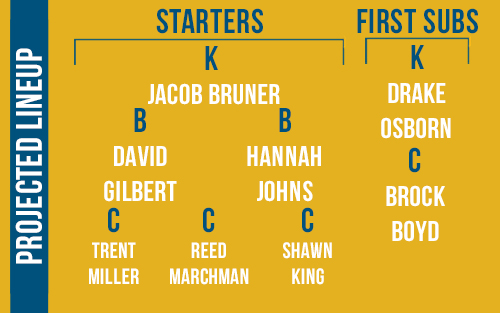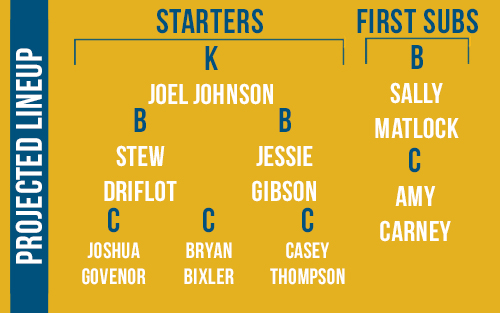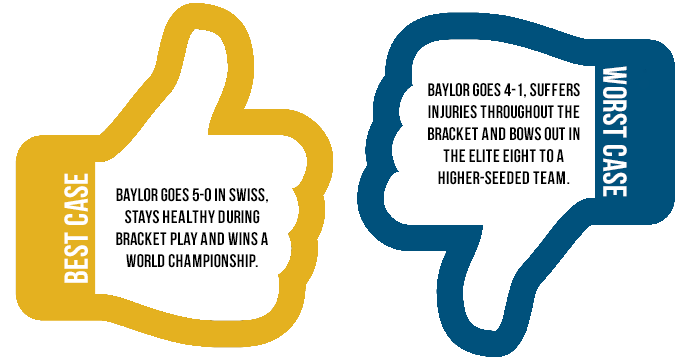Antwerp QC, Much of Belgian Core, Leaves Competitive Quidditch
Rock Hill Roll Call is your in-depth guide to the 80 teams that will compete for the title of World Cup 8 Champion. We’ve reached out to writers and analysts all over the country to bring you the lineups, strategies, focal points and aspirations of each and every attending team. Whether you are looking for a leg up on the competition or just want a detailed preview of the sport’s main event, this is the place for you.
 By Mitch Cavender
By Mitch Cavender
Baylor University hobbled away from Southwest Regional with an impressive second-place finish. That’s right–hobbled, with beater Timothy Brestowski limping away with the assistance of a broom-cane and beater Brittany Ripperger being carried from the fields by a human-gurney of her peers. The Bears are limping into World Cup, but wounded animals are the most dangerous.
 Fortunately for Baylor, the Bears have one of the most dangerous beasts in the entire game lining up between their hoops: Jacob Bruner. There is probably no player in quidditch more deserving of a hype train than Baylor’s behemoth of a keeper. And that’s essentially what he is on the field–a runaway freight train. Criminally underrated for years, Bruner finally started garnering mainstream attention at this year’s Southwest Regional Championship, where he consistently plowed through the University of Texas defense like a Golem on its 10th-straight turn of “rollout.”
Fortunately for Baylor, the Bears have one of the most dangerous beasts in the entire game lining up between their hoops: Jacob Bruner. There is probably no player in quidditch more deserving of a hype train than Baylor’s behemoth of a keeper. And that’s essentially what he is on the field–a runaway freight train. Criminally underrated for years, Bruner finally started garnering mainstream attention at this year’s Southwest Regional Championship, where he consistently plowed through the University of Texas defense like a Golem on its 10th-straight turn of “rollout.”
What makes this Baylor keeper so incredibly difficult to stop? Versatility. Unlike most drivers, Bruner doesn’t need to be 2 feet from the hoops to score. This Bear can shoot. If you think you have him wrapped up in transition, he can still hit you with a shot from more than 15 yards out, or flick an assist to rangy wingers such as Trent Miller, Steffi Hoffman and Reed Marchman. Bruner anchors the Baylor quaffle game, and with the beater depth chart—aside from David Gilbert—in flux, the Bears will need to lean on their man in the middle more than ever before.
In the past, keepers primarily drove. Now, keepers primarily distribute. Bruner does both with surgical precision. He is the Ghost of Quidditch Yet To Come and it is he who must convince Benepenezer Scrooge to replace Tiny Tim Brestowski’s rickety crutch with an Alivan’s championship broom.
 By Anonymous
By Anonymous
Three years ago, Baylor’s unique defense shocked the quidditch world. University of Minnesota, University of Kansas, and others had tried similar hoop-defending ploys, but no team has enjoyed the same amount of success as Baylor’s version. As quidditch strategy has developed, however, more teams are starting to come up with ways to break the Bears’ zone. Combine this with the fact that their beaters aren’t nearly as dominant in the game as they used to be, and you’ll see Baylor have a harder time putting teams out of range this year at World Cup.
Baylor was so reliant on its defense for keeping the opponents score low, it has never truly developed an offense. Most of the team’s goals come on no-bludger drives and lucky mid- to long-range shots. If a team plays Baylor methodically, retains bludger control for most of the game and restricts Baylor’s no-bludger opportunities, it could upset Baylor.
With Ripperger out for the season, Baylor is left with only a month to train its formerly third-string beater and hope this individual is a competent sub for now-starting beater, Hannah Johns. As we’ve seen all season, Baylor’s female beaters are prone to injury, forcing the Bears to play a two-male beating set, which weakens their already simple offense. Baylor will have to keep its players healthy and work on adjusting mid-game if it hope to find success in Rock Hill.
 By Philip O’Brien
By Philip O’Brien
Texas Tech University is one of the youngest teams in the Southwest, but it plays an intelligent and physical style of quidditch. Building off of its first appearance at World Cup last April, the team has continued an upward trajectory under the wing of captains Josh Carroll and Derek Malone. Somehow, this team has remained relatively unknown in the quidditch community, but if it plays to their potential, this will not be the case next season.
The Red Raiders should have a full roster for World Cup 8, which will serve them well in this new Swiss format. This team is well balanced with depth in male keepers and chasers, smart beater play and a new star seeker.
Texas Tech’s biggest strength is its stingy defense. However, its offense has been rather unpredictable. Although the team has an efficient offensive strategy that relies on the keeper making the proper read and an accurate pass, it has been a hit or miss for the Red Raiders throughout this season. Keeper Malone does a great job of breaking past point chasers, but has been inconsistent with his accuracy on passes when the opposing beaters stop his advance. He will need to make smart and accurate passes and minimize the turnovers for Texas Tech’s offense to succeed.
 The main recipient of Malone’s passes is sophomore standout Sean Townsend. Townsend, who is the team’s leading scorer and star seeker in addition to playing heavy minutes at point chaser, may be the most indispensable player on this team. The second unit is led by the hard-hitting Kevin Tran, who is the most accurate passer on the team and an excellent driver, while senior Tyler “Scrub Lord” Jewell leads the third unit.
The main recipient of Malone’s passes is sophomore standout Sean Townsend. Townsend, who is the team’s leading scorer and star seeker in addition to playing heavy minutes at point chaser, may be the most indispensable player on this team. The second unit is led by the hard-hitting Kevin Tran, who is the most accurate passer on the team and an excellent driver, while senior Tyler “Scrub Lord” Jewell leads the third unit.
As previously mentioned, this team has a very deep and athletic male chaser line. However, it is probably the most inexperienced group in the Southwest, and this lack of experience shows at times in the Red Raiders’ offensive execution. Their defensive effort, on the other hand, is stellar and keeps them competitive in every game they play. As deep as the male chaser line is, though, the same cannot be said about the female line. There are currently only two female chasers on the roster: first-year players Mikayla Williams and Taylor Simons. Although Williams and Simons have shown aggression, they will need to gain more confidence and develop their skills before they can become major contributors.
In order for Texas Tech to have a chance to advance to bracket play, seeker Townsend is going to have to continue his stellar play of late. Last season, Texas Tech had only a 32 percent snitch-catch percentage. This season, with Townsend as the primary seeker, it is at 69 percent with an impressive 100 percent catch rate at the Southwest Regional. Considering the defensive-minded nature of the team, it is likely to be involved in several snitch-range games at World Cup 8, and Townsend’s success rate will be vital for the Red Raiders’ chances to advance.
 By Philip O’Brien
By Philip O’Brien
Texas Tech’s notable trait is the stinginess and adaptability of its defense, which is led by an outstanding beater corps–one of the best in the Southwest outside of the Elite Four. Impressive defensive performances include holding Texas A&M University to 30 points at Brooms On The Brazos and holding Lone Star Quidditch Club to its lowest scoring performance of the tournament at the Southwest Regional.
Veteran and captain Carroll leads this unit by using his strength to avoid opponents’ attempts to bring him to the ground and by using his positioning to affect the quaffle game without needing to make risky throws.
His years of experience aid him in being able to adjust his play regardless of his opponents’ offensive strategy. Carroll’s backup, sophomore Oak Pinratana, has great potential with impressive strength and positioning. When he plays well early in a game, he can become a dominant force; however, when he misses a throw or two early on, he has a tendency to struggle for the rest of the game. Katelynn Moranha, a chaser-turned-beater, has really come into her own this year. She is very strong, able to keep her bludger under duress and makes smart throws. Needless to say, this unit’s strength is in maintaining bludger control and thereby controlling the beater play.
Texas Tech runs a very effective mix of man defense and Baylor defense, depending on the bludger situation. Its solid beating often forces opponents to make long passes, which 6-foot-5 keeper Malone is easily able to block and intercept with his massive wingspan. The second unit, led by Tran, includes chasers Zack New and Stephan Vigil and brings a high level of physicality to the game that allows this group to confidently call themselves the “Legion of Boom.” The combination of tough keeper and chaser defense and dependable beater play makes Texas Tech one of the best defenses in the Southwest.
 By Dan Hanson
By Dan Hanson
Few, if any, teams in the league have an x-factor as apparent as Boise State University’s Stewart Driflot.
Driflot spends the majority of the game playing the position he is worst at: beater. So if you are drafting him for a fantasy team, you should pick him in early rounds for his abilities as a seeker, a ball-carrying distributor and an off-ball scorer, but the Abraxans have built their strategy perfectly around Driflot at beater.
Instead of the quaffle constantly in Driflot’s capable hands, it is in Joel Johnson’s possession. Johnson is fast and lanky with a nice passing touch and good field vision. When there are no bludgers on defense, the quaffle can safely ride the Bryan Bixler train straight through the hoops. On one wing is fresh, all-around talent Joshua Govenor, and on the other, is about as tall and strong a minority gender player as you will ever find in Casey Thompson. Both can pass, drive, dunk and score from midrange.
 In spite of a team that has developed well and established a great identity and chemistry, Driflot is still the centerpiece. He starts offensive drives with aggressive beater play, sometimes with a bludger in hand and sometimes without, but effective in either situation. Boise’s capable back beater rotation of Jessie Gibson and Sally Matlock are able to excel in a role where Driflot does the trenchwork.
In spite of a team that has developed well and established a great identity and chemistry, Driflot is still the centerpiece. He starts offensive drives with aggressive beater play, sometimes with a bludger in hand and sometimes without, but effective in either situation. Boise’s capable back beater rotation of Jessie Gibson and Sally Matlock are able to excel in a role where Driflot does the trenchwork.
The biggest problem for Boise lies at the 18-minute mark. Driflot has to leave the field so he can return as seeker. Lang Truong takes Driflot’s place at beater, and, while Truong plays very well, Boise’s entire offense must operate differently without Driflot. The Abraxans learned this the hard way when they coughed up a 100-10 chokehold on University of British Columbia in the semifinals and let their rivals get back in range with Driflot in at seeker before regaining control of the game.
Boise can make the ball fly around opponents’ keeper zones in the Northwest, but its revamped lineup and strategies have yet to be tested outside of the region. The history of the entire region will rest squarely on Driflot’s shoulders in Rock Hill.
 By Anonymous
By Anonymous
Boise’s two main opponents this season are the ultra-aggressive British Columbia and the ultra-conservative Western Washington University. Boise feasts on the conservative. To beat the Abraxans, it is best to fight their fire with your fire. If you catch Driflot out of position at beater and force their offense’s hand, you can create your own opportunities while stifling theirs. If Boise dictates the pace, it can use its offensive and defensive skills to stay close and steal wins with seeker Driflot. However, a defense that forces the pace of the game will cause Boise to make passes from too great of a distance. An aggressive offense that passes well will be able to take advantage of Boise’s occasional lapses in defense. Boise is great at defending the point with chasers and beaters, but once a first pass is completed cleanly, its players have a lot more trouble staying organized.
The snitch will be crucial in matches with Boise. If the snitch is short and cannot outrun Driflot, you have no choice but to be out of range. However, a strong snitch can give you a few minutes to push Boise out of range.
While the Abraxans have a threatening offense and a defense that loves to make strong hits, the key to putting this team away is to exploit its inexperience. Boise will have to greatly adapt at World Cup to keep up with teams and strategies the team has never faced before.
Graphics and photo illustration by Amanda Dallas. Original photos by Monica Wheeler (top) and Will Michels (bottom).
Archives by Month:
- April 2025
- May 2023
- April 2023
- April 2022
- January 2021
- October 2020
- September 2020
- July 2020
- May 2020
- April 2020
- March 2020
- February 2020
- January 2020
- December 2019
- November 2019
- October 2019
- August 2019
- April 2019
- March 2019
- February 2019
- January 2019
- November 2018
- October 2018
- September 2018
- August 2018
- July 2018
- June 2018
- April 2018
- March 2018
- February 2018
- January 2018
- November 2017
- October 2017
- July 2017
- June 2017
- May 2017
- April 2017
- March 2017
- February 2017
- January 2017
- December 2016
- November 2016
- October 2016
- September 2016
- August 2016
- July 2016
- June 2016
- May 2016
- April 2016
- March 2016
- February 2016
- January 2016
- December 2015
- November 2015
- October 2015
- September 2015
- August 2015
- July 2015
- June 2015
- May 2015
- April 2015
- March 2015
- February 2015
- January 2015
- December 2014
- November 2014
- October 2014
- September 2014
- August 2014
- July 2014
- May 2014
- April 2014
- March 2014
- February 2014
- January 2014
- November 2013
- October 2013
- September 2013
- August 2013
- July 2013
- June 2013
- May 2013
- April 2013
- March 2013
- February 2013
- January 2013
- December 2012
- November 2012
- October 2012
Archives by Subject:
- Categories
- Awards
- College/Community Split
- Column
- Community Teams
- Countdown to Columbia
- DIY
- Drills
- Elo Rankings
- Fantasy Fantasy Tournaments
- Game & Tournament Reports
- General
- History Of
- International
- IQA World Cup
- Major League Quidditch
- March Madness
- Matches of the Decade
- Monday Water Cooler
- News
- Positional Strategy
- Press Release
- Profiles
- Quidditch Australia
- Rankings Wrap-Up
- Referees
- Rock Hill Roll Call
- Rules and Policy
- Statistic
- Strategy
- Team Management
- Team USA
- The Pitch
- The Quidditch Lens
- Top 10 College
- Top 10 Community
- Top 20
- Uncategorized
- US Quarantine Cup
- US Quidditch Cup







